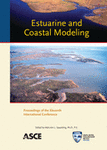Hydrodynamic Analyses of Restoration Actions in the Flood Plain
Publication: Estuarine and Coastal Modeling (2009)
Abstract
Over the last century, considerable near-shore tidal marshland as well as upriver freshwater habitat has been lost due to diking for agriculture, flood protection, and other development. While efforts to restore degraded coastal / estuarine habitats and re-establish migratory pathways for salmon, receive considerable attention and are supported through complex 3-D coastal circulation modeling, upstream restoration actions are sometimes neglected. The traditional approach of modeling upstream reaches has been to utilize one-dimensional hydraulic models developed for FEMA flooding analyses. While this approach may be sufficient for engineering design for peak flood protection, it is inadequate for most high flow events where flood waters often leave the channel and flow across the floodplain in a complex manner. This paper presents a hydrodynamic modeling analysis of the Skagit River and its floodplain to evaluate the effect of a proposed restoration project on flooding. It also shows the feasibility and advantages of using an unstructured multidimensional model for conducting such analyses. The site was located at approximately RM 28.5, within the lower Skagit River floodplain but upstream of tidal influence. The restoration proposal involves removal of a section of the existing dike as it is thought to be degrading habitat of the floodplain downstream by preventing flow into historic channels that could potentially provide refugia for salmon during migration. Previously a hydrodynamic model of the Skagit Basin including the Skagit Bay, estuary, and the flood plain was developed using the unstructured, three-dimensional model FVCOM. The approach used in the current study was to include the river channel and floodplain in the model domain, with inflow specified at the upstream end covering approximately 37 miles of river channel and floodplain. Because the study area is above tidal influence, measure water surface elevation data were used as the downstream boundary conditions. The results show the change in hydrodynamic conditions from the proposed project. A brief discussion is given on the potential of the modeling approach to provide the connectivity needed to properly analyze the Skagit River system from the North Cascades Mountains to the Skagit Bay for water quality, food web dynamics, and climate change.
Get full access to this article
View all available purchase options and get full access to this chapter.
Information & Authors
Information
Published In
Copyright
© 2010 American Society of Civil Engineers.
History
Published online: Apr 26, 2012
Authors
Metrics & Citations
Metrics
Citations
Download citation
If you have the appropriate software installed, you can download article citation data to the citation manager of your choice. Simply select your manager software from the list below and click Download.
